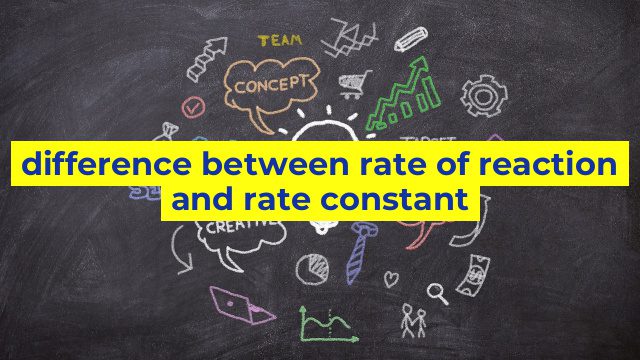The Difference Between Rate of Reaction and Rate Constant
Introduction
In the field of chemistry, reactions are the foundation of understanding how different substances interact with each other to form new compounds. In order to comprehend the mechanisms of these reactions, scientists use different parameters to quantify the rates at which these reactions occur. Two of the most important parameters used in reaction kinetics are rate of reaction and rate constant. Although these two terms sound similar, they are fundamentally different in their meaning and application. This article will explore the differences between rate of reaction and rate constant.
What is Rate of Reaction?
The rate of reaction is defined as the change in concentration of a reactant or product over a given time period. It is expressed in units of molarity per second (M/s) or moles per liter per second (mol/L/s). Essentially, rate of reaction indicates how quickly or slowly a chemical reaction is occurring. The rate of a reaction is influenced by factors such as concentration of reactants, temperature, surface area, and the presence of a catalyst.
What is Rate Constant?
The rate constant is defined as the proportionality constant that relates the rate of a chemical reaction to the concentration of the reactants. It is denoted by the symbol k and has units of inverse time (s^-1). The rate constant is used to predict the progress of a reaction and helps in determining the order of the reaction. The value of the rate constant is influenced by factors such as temperature, presence of a catalyst and the nature of the reaction.
Key Differences between Rate of Reaction and Rate Constant
The key differences between rate of reaction and rate constant can be summarized as follows:
1. Rate of reaction is a measure of the change in concentration of a reactant or product over a given time period while rate constant is a proportionality constant that relates the rate of reaction to the concentration of reactants.
2. Rate of reaction is expressed in units of molarity per second (M/s) or moles per liter per second (mol/L/s) while rate constant is given in units of inverse time (s^-1).
3. The rate of reaction is affected by factors such as the concentration of reactants, temperature, surface area, and the presence of a catalyst while the rate constant is influenced by factors such as temperature, presence of a catalyst, and the nature of the reaction.
Conclusion
In conclusion, the rate of reaction and rate constant are both important parameters for understanding chemical reactions. Rate of reaction measures how quickly the reaction occur while rate constant relates the rate of reaction with the concentration of the reactants. While the two terms may seem similar, it is crucial to differentiate between them for proper interpretation of experimental data. Understanding these fundamental concepts is necessary for comprehending the kinetics of a chemical reaction.
Table difference between rate of reaction and rate constant
| Rate of Reaction | Rate Constant |
|---|---|
| Depends on concentration of reactants | Constant value for a given reaction at a specific temperature |
| Can be changed by altering concentration, temperature and surface area of reactants | Does not change with variation in concentration, temperature and pressure |
| Units include concentration/time (e.g. M/s) | Units depend on the order of the reaction (e.g. s^-1, M^-1 s^-1) |
| Describes how quickly the reactants are being used up or the products are being formed | Describes the ratio of the rate of the reaction to the concentration of the reactants |


